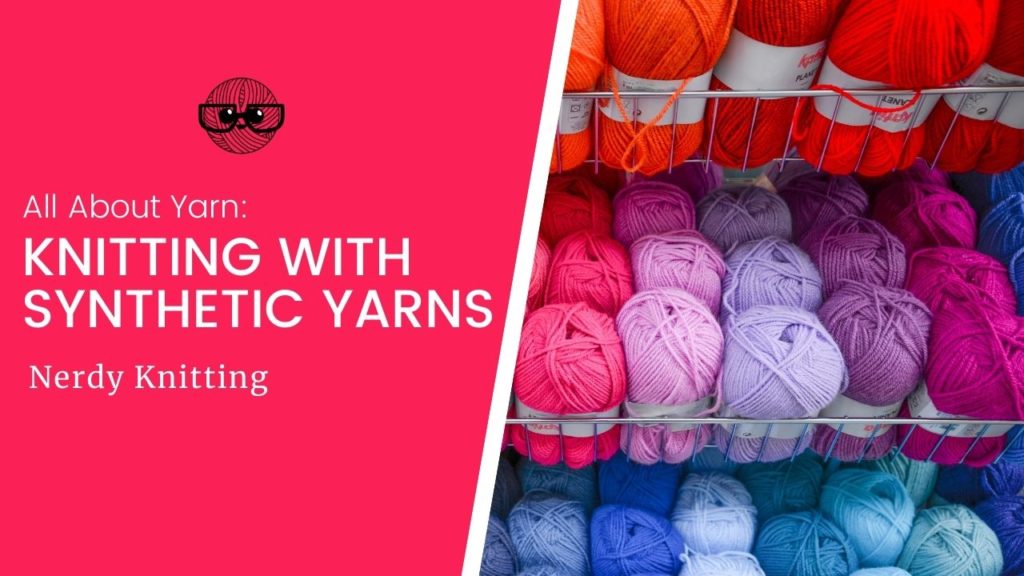Synthetic yarns are one of most-used yarns in the knitting world – but not without a certain amount of controversy. Many knitters, who consider themselves ‘yarn snobs’ would never touch the stuff, while others who are on a tight budget are looking for affordable yarns for knitting. And knitting with synthetic yarns definitely falls in the budget-friendly category.
Synthetic yarns certainly have a place in the knitting world – and not just because they are budget-friendly. We’ll take a look at why you should consider giving them a try, including these topics:
- How Synthetic Yarns are Made
- Basic Properties of Synthetic Yarns
- Caring for Hand Knits
- Three Common Synthetic Yarns
Let’s take a closer look at each of these areas. Then you’ll know exactly when you might want to choose a synthetic yarn for your next knitting project.
Some links below are affiliate links. If you click through and make a purchase I may receive a small commission at no extra cost to you. See the disclosure policy for more information.
How Synthetic Yarns are Made
All the various fibers that can be used for knitting can be divided into four basic categories – animal fibers (like wool, silk, and alpaca), plant fibers (like cotton and linen), biosynthetic fibers (like rayon and bamboo), and synthetic fibers (like acrylic and nylon). In this article we’re focusing on that last category – the yarns that come from synthetic sources.
All synthetic, man-made yarns, begin with the same process. The source material that is used for the fiber (most synthetics come from various petrochemical sources) is mixed and turned into a liquid. This thick liquid is then extruded through a spinneret with various sizes of holes (the diameter of the holes determines the circumference of the filaments). As the liquid congeals when it’s pushed through, it forms long filament threads. These threads can then be spun into yarn – either alone or with other fiber sources.
They can also be stretched or cut into staple lengths that are similar to natural fibers before being combed and spun into yarn. In the end, that mixture of petroleum-based man-made materials ends up looking and feeling like real, natural fibers.
Each step in the process can be changed to create brand new yarns – that’s why you’ll see plenty of novelty yarns available using synthetic fibers for their base material. The size of the holes in the spinneret can be changed, the filaments can be cut and and blended in various ways – making it an inexpensive and easy method for creating popular novelty yarns.
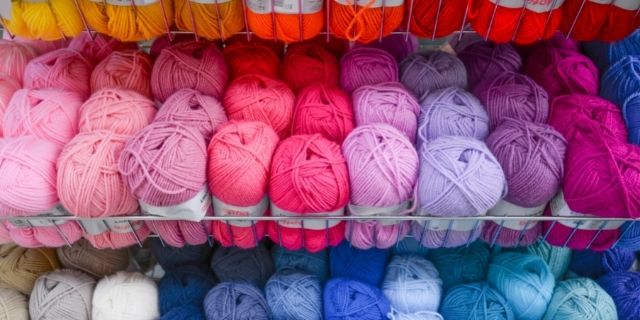
Basic Properties of Synthetic Yarns
Now that you synthetic fibers are turned into useable yarn, let’s look at the properties that are generally found in synthetic fibers. While each synthetic fiber has specific properties that define them, all synthetic fibers share some basic general characteristics.
Advantages of Synthetic Yarns
The first general property that synthetic fibers share is their strength and durability. All synthetic fibers are quite strong. That’s why you’ll often find nylon blended into a sock yarn – for extra durability. Garments knit with synthetic fibers tend to hold their shape well because of this inherent strength.
Synthetic fibers are made with ease of care in mind – the three listed below are all machine-washable. They can also be put in the dryer but you should always use a low-heat setting (synthetics are derived from the same source as plastic and they can melt if subjected to high temperatures). This makes them a great choice for projects that need to be washed often – like kids clothing.
Synthetic fibers are also non-allergenic for those who cannot tolerate wool or have allergies to wool or lanolin. And they are also inexpensive, lightweight, and elastic. Of course, these characteristics vary from one synthetic fiber to the next.
Disadvantages of Synthetic Yarns
While synthetic yarns have some qualities that make them a nice source for yarn, there are some drawbacks as well.
All synthetic fibers are water-resistant, which can be a good thing because the final garment will dry quickly. But this water-resistance also makes them harder to get clean because water can’t penetrate the fibers so greasy stains and odours are harder to remove. The water-resistant nature of synthetic yarns also makes the garment less breathable (that ‘clammy’ feeling you can get when wearing a synthetic garment is caused by the water-resistant properties in synthetic fibers).
Synthetic fibers are not as warm as garments knit with wool. Wool (which is basically hair) traps the heat in the cortex of the fibers and insulates and warms the body. Synthetic fibers do not have this inherent trait so they can’t retain heat like a wool garment.
Synthetic fibers are also extremely heat sensitive and should not be exposed to high heats or flames. While hot steam can be used to set the fabric, anything more should not be used. When exposed to flames these fibers will actually melt – they are just alternate forms of plastic (so don’t make any pot holders or trivets with synthetic yarns).
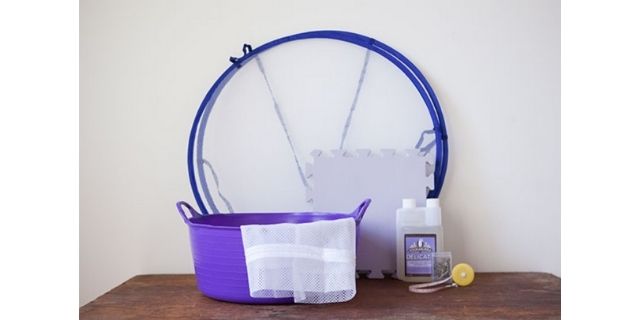
Caring for Hand Knits
Synthetic fibers are generally machine-washable and dry-able. As with any knitting project, a gentle cycle is always a good idea for washing and choose a low-heat setting for the dryer (high heat is not recommended for synthetic fibers). But you should always check the yarn label of your yarn for specific care instructions.
Most acrylic yarns are machine-washable and can even be put in the dryer on low heat. Be careful of putting acrylic yarns in the dryer on a high-heat setting because acrylic fibers are heat sensitive and can actually melt.
Nylon is easy to care for – it is machine-washable and can be put in the dryer. Because nylon is often used in a blend with other fibers, the care needs for those fibers dictate how the final yarn should be cared for. Check the yarn label for appropriate care instructions for your yarn. Nylon is heat sensitive and may melt if it comes into direct contact with an iron, flame, or is put into a dryer on a high-heat setting.
Polyester yarn is usually easy to care for so can be washed in the washing machine and dried on a low-heat setting in the dryer. If it’s blended with other fibers you’ll want to refer to the ball band on the yarn for specific care instructions because the additional fibers may change the care needs for the yarn.
Polyester is not heat resistant and will shrink if exposed to high heat. Use low heat settings when drying polyester yarns and use the lowest iron setting that will produce steam if you are steaming the final garment.
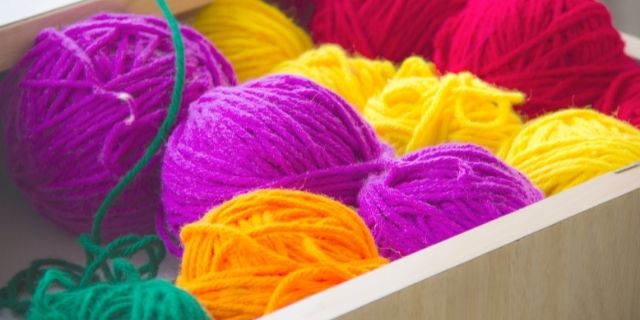
Three Common Synthetic Yarns
The three synthetic fibers listed here are the most common synthetics found in commercially-available yarns. They are all inexpensive, strong, durable, lightweight fibers that bring those attributes to any other fibers they may be blended with.
Acrylic Yarn
Acrylic yarn is the most popular synthetic fiber and yarns made from acrylic fibers can be found in local big-box stores as well as small local yarn shops. Even popular brands that focus on higher-end yarns or luxury fibers may carry acrylic blends.
Acrylic yarn actually has a long list of benefits. It’s perfect for hard-wearing projects that need to be tossed in the washing machine. here are some of the other benefits of acrylic yarn:
- inexpensive
- widely-available
- wide-range of colors
- soft
- lightweight
- durable
- water-resistant
- machine-washable
- resilient
- doesn’t shrink
- easily dye-able
Learn more about acrylic yarn in this article: All About Knitting Acrylic Yarn (everything you need to know)
Nylon Yarn
Nylon is a man-made polyamide fiber that was invented before World War II and went on to be used in many different things, including women’s nylon stockings. In knitting, nylon is often included in yarns to add additional strength, elasticity, and durability but can be spun and put into 100% nylon yarns as well. It is commonly used in novelty yarns as well as sock yarns.
Nylon is often included in small amounts in a yarn because it adds strength, elasticity, and durability – something that is desirable in many yarns, especially delicate or inelastic fibers. In this case, nylon isn’t the star of the show, it simply helps out other fibers and makes the yarns more useful for a wider variety of knitting projects.
Learn more about nylon yarn in this article: Knitting with Nylon: 8 Interesting Questions
Polyester Yarn
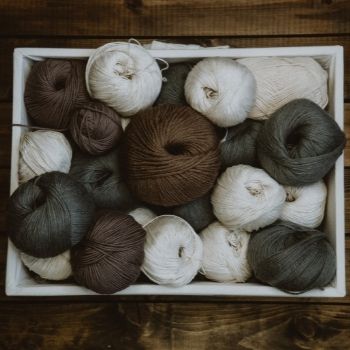
Polyester yarn is similar to acrylic yarn. It is a polymer-based material that is basically a form of plastic (and shares some similarities to plastic soda bottles). You’ll often find it listed using any of the following trademarked brand names: Dacron, Fiberfill, Coolmax, Microlux.
Polyester is usually blended with other fibers to create lightweight, strong garments with good elasticity, as well as being easy to care for. It’s a good choice for garments that will need to be washed and dried often, like kid’s clothing, baby items (like blankets or bibs), or knit items that will be donated.
Learn more about polyester yarn in this article: 8 Basic Facts about Knitting with Polyester Yarn
Get the Yarn Substitution Checklist
Fill in the form below to get a free copy of the Four Step Checklist for substituting yarn. Use it for your next knitting project!

More Questions about Knitting with Synthetic Yarns
While we’ve covered a great deal of information, you may be looking for an answer to one simple question. Here are a few of the commonly asked questions about knitting with synthetic yarns.
Do synthetic fibers melt?
Synthetic fibers are manufactured from a variety of petrochemical sources (plastics). If they are exposed to high temperatures they will melt and can even cause serious burns.
What are the pros and cons of synthetic fibers?
Synthetic fibers are inexpensive to produce, strong, durable, lightweight fibers that bring those attributes to any other fibers they may be blended with. But they also lack breathability and warmth, are prone to absorbing odours, and heat sensitive.
Why is acrylic preferred over wool?
Acrylic is often preferred over wool because it is easily available at most local big-box stores, it’s less expensive, and it is machine-washable.
What can I knit with acrylic yarn?
Acrylic yarn is great for garments and items that need to be durable and easy to care for like children’s clothing. It’s also a good choice for any items knit for charity or donations as the donated items generally need to be machine-washable.
What is polyester yarn good for?
Polyester is usually blended with other fibers to create lightweight, strong garments with good elasticity, as well as being easy to care for. It’s a good choice for garments that will need to be washed and dried often, like kid’s clothing, baby items (like blankets or bibs), or knit items that will be donated.
Now you’re prepared to explore synthetic fibers in more depth or, now that you know how they are best used, start knitting with them. If you’re looking for more information about different fibers for knitting, take a look at the resources and articles linked below.
More About Yarns & Fibers
- The Knitter’s Book of Yarn by Clara Parkes (available at Amazon)
- Yarn Substitution Made Easy by Carol J. Sulcoski (available at Amazon)
- The Fleece & Fiber Sourcebook by Carol Ekarius & Deborah Robson (available at Amazon)
